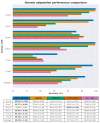A Novel Deep Learning Model for the Detection and Identification of Rolling Element-Bearing Faults
- PMID: 32911771
- PMCID: PMC7570750
- DOI: 10.3390/s20185112
A Novel Deep Learning Model for the Detection and Identification of Rolling Element-Bearing Faults
Abstract
Real-time acquisition of large amounts of machine operating data is now increasingly common due to recent advances in Industry 4.0 technologies. A key benefit to factory operators of this large scale data acquisition is in the ability to perform real-time condition monitoring and early-stage fault detection and diagnosis on industrial machinery-with the potential to reduce machine down-time and thus operating costs. The main contribution of this work is the development of an intelligent fault diagnosis method capable of operating on these real-time data streams to provide early detection of developing problems under variable operating conditions. We propose a novel dual-path recurrent neural network with a wide first kernel and deep convolutional neural network pathway (RNN-WDCNN) capable of operating on raw temporal signals such as vibration data to diagnose rolling element bearing faults in data acquired from electromechanical drive systems. RNN-WDCNN combines elements of recurrent neural networks (RNNs) and convolutional neural networks (CNNs) to capture distant dependencies in time series data and suppress high-frequency noise in the input signals. Experimental results on the benchmark Case Western Reserve University (CWRU) bearing fault dataset show RNN-WDCNN outperforms current state-of-the-art methods in both domain adaptation and noise rejection tasks.
Keywords: artificial intelligence; condition monitoring; deep learning; fault diagnosis.
Conflict of interest statement
The authors declare no conflict of interest.
Figures














References
-
- Motor Reliability Working Group Report of Large Motor Reliability Survey of Industrial and Commercial Installations, Part I. IEEE Trans. Ind. Appl. 1985;IA-21:853–864.
-
- Thorsen O., Dalva M. A survey of faults on induction motors in offshore oil industry, petrochemical industry, gas terminals, and oil refineries. IEEE Trans. Ind. Appl. 1995;31:1186–1196. doi: 10.1109/28.464536. - DOI
-
- Bonnett A.H., Yung C. Increased Efficiency Versus Increased Reliability. IEEE Ind. Appl. Mag. 2008;14:29–36. doi: 10.1109/MIA.2007.909802. - DOI
-
- McFadden P.D., Smith J.D. Model for the vibration produced by a single point defect in a rolling element bearing. J. Sound Vib. 1984;96:69–82. doi: 10.1016/0022-460X(84)90595-9. - DOI
-
- Hochmann D., Bechhoefer E. Envelope bearing analysis: Theory and practice; Proceedings of the 2005 IEEE Aerospace Conference; Big Sky, MT, USA. 5–12 March 2005; pp. 3658–3666.
Grants and funding
LinkOut - more resources
Full Text Sources

